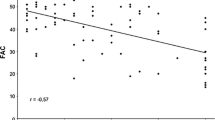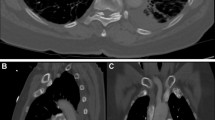Abstract
Regional right ventricular (RV) dysfunction (RRVD) is an echocardiographic feature in acute pulmonary embolism (PE), primarily reported in patients with moderate-to-severe RV dysfunction. This study investigated the clinical importance of RRVD by assessing its relationship with clot burden and biomarkers. We identified consecutive patients admitted to the emergency department between 1999 and 2014 who underwent computed tomographic angiography, echocardiography, and biomarker testing (troponin and NT-proBNP) for suspected acute PE. RRVD was defined as normal excursion of the apex contrasting with hypokinesis of the mid-free wall segment. RV assessment included measurements of ventricular dimensions, fractional area change, free-wall longitudinal strain and tricuspid annular plane systolic excursion. Clot burden was assessed using the modified Miller score. Of 82 patients identified, 51 had acute PE (mean age 66 ± 17 years, 43 % male). No patient had RV myocardial infarction. RRVD was present in 41 % of PEs and absent in all patients without PE. Among patients with PE, 86 % of patients with RRVD had central or multi-lobar PE. Patients with RRVD had higher prevalence of moderate-to-severe RV dilation (81 vs. 30 %, p < 0.01) and dysfunction (86 vs. 23 %, p < 0.01). There was a strong trend for higher troponin level in PE patients with RRVD (38 vs. 13 % in PE patients without RRVD, p = 0.08), while there was no significant difference for NT-proBNP (67 vs. 73 %, p = 0.88). RRVD showed good concordance between readers (87 %). RRVD is associated with an increased clot burden in acute PE and is more prevalent among patients with moderate-to-severe RV enlargement and dysfunction.





Similar content being viewed by others
References
McConnell MV, Solomon SD, Rayan ME, Come PC, Goldhaber SZ, Lee RT (1996) Regional right ventricular dysfunction detected by echocardiography in acute pulmonary embolism. Am J Cardiol 78:469–473
Goldhaber SZ (1998) Pulmonary embolism. N Engl J Med 339:93–104
Sosland RP, Gupta K (2008) Images in cardiovascular medicine: McConnell’s Sign. Circulation 118:e517–e518
Torrent Guasp F (2001) Agonist-antagonist mechanics of the descendent and ascendent segments of the ventricular myocardial band. Rev Esp Cardiol 54:1091–1102
Bankier AA, Janata K, Fleischmann D, Kreuzer S, Mallek R, Frossard M et al (1997) Severity assessment of acute pulmonary embolism with spiral CT: evaluation of two modified angiographic scores and comparison with clinical data. J Thorac Imaging 12:150–158
Voigt J-U, Pedrizzetti G, Lysyansky P, Marwick TH, Houle H, Baumann R et al (2015) Definitions for a common standard for 2D speckle tracking echocardiography: consensus document of the EACVI/ASE/Industry Task Force to standardize deformation imaging. Eur Heart J Cardiovasc Imaging 16:1
Rudski LG, Lai WW, Afilalo J, Hua L, Handschumacher MD, Chandrasekaran K et al (2010) Guidelines for the echocardiographic assessment of the right heart in adults: a report from the American Society of Echocardiography endorsed by the European Association of Echocardiography, a registered branch of the European Society of Cardiology, and the Canadian Society of Echocardiography. J Am Soc Echocardiogr 23:685–713
Geyer H, Caracciolo G, Abe H, Wilansky S, Carerj S, Gentile F et al (2010) Assessment of myocardial mechanics using speckle tracking echocardiography: fundamentals and clinical applications. J Am Soc Echocardiogr 23:351–369
Lang RM, Badano LP, Mor-Avi V, Afilalo J, Armstrong A, Ernande L et al (2015) Recommendations for cardiac chamber quantification by echocardiography in adults: an update from the American Society of Echocardiography and the European Association of Cardiovascular Imaging. J Am Soc Echocardiogr 28:1–39
Konstantinides SV, Torbicki A, Agnelli G, Danchin N, Fitzmaurice D, Galiè N et al (2014) 2014 ESC guidelines on the diagnosis and management of acute pulmonary embolism. Eur Heart J 35:3033–3069
Kurzyna M, Torbicki A, Pruszczyk P, Burakowska B, Fijałkowska A, Kober J et al (2002) Disturbed right ventricular ejection pattern as a new Doppler echocardiographic sign of acute pulmonary embolism. Am J Cardiol 90:507–511
Platz E, Hassanein AH, Shah A, Goldhaber SZ, Solomon SD (2012) Regional right ventricular strain pattern in patients with acute pulmonary embolism. Echocardiography 29:464–470
López-Candales A, Edelman K, Candales MD (2010) Right ventricular apical contractility in acute pulmonary embolism: the McConnell sign revisited. Echocardiography 27:614–620
Lodato JA, Ward RP, Lang R (2008) Echocardiographic predictors of pulmonary embolism in patients referred for helical CT. Echocardiography 25:584–590
Vedovati M, Becattini C, Agnelli G, Kamphuisen P, Masotti L, Pruszczyk P et al (2012) Multidetector CT scan for acute pulmonary embolism: embolic burden and clinical outcome. Chest 142:1417–1424
Pruszczyk P, Kostrubiec M, Bochowicz A, Styczyński G, Szulc M, Kurzyna M et al (2003) N-terminal pro-brain natriuretic peptide in patients with acute pulmonary embolism. Eur Respir J 22:649–653
Becattini C, Vedovati MC, Agnelli G (2007) Prognostic value of troponins in acute pulmonary embolism: a meta-analysis. Circulation 116:427–433
Kucher N, Goldhaber SZ (2003) Cardiac biomarkers for risk stratification of patients with acute pulmonary embolism. Circulation 108:2191–2194
Shah P, Schleifer JW, Mookadam F, Chandrasekaran K (2015) Right ventricular myocardial infarction: an underrecognized aetiology of McConnell’s sign. Eur Heart J Cardiovasc Imaging 16:225
Casazza F, Bongarzoni A, Capozi A, Agostoni O (2005) Regional right ventricular dysfunction in acute pulmonary embolism and right ventricular infarction. Eur J Echocardiogr 6:11–14
Jaff MR, McMurtry MS, Archer SL, Cushman M, Goldenberg N, Goldhaber SZ et al (2011) Management of massive and submassive pulmonary embolism, iliofemoral deep vein thrombosis, and chronic thromboembolic pulmonary hypertension: a scientific statement from the American Heart Association. Circulation 123:1788–1830
Raina A, Vaidya A, Gertz ZM, Chambers S, Forfia PR (2013) Marked changes in right ventricular contractile pattern after cardiothoracic surgery: implications for post-surgical assessment of right ventricular function. J Heart Lung Transplant 32:777–783
Sugiura E, Dohi K, Onishi K, Takamura T, Tsuji A, Ota S et al (2009) Reversible right ventricular regional non-uniformity quantified by speckle-tracking strain imaging in patients with acute pulmonary thromboembolism. J Am Soc Echocardiogr 22:1353–1359
Acknowledgments
M.A. received a research fellowship from the Fédération Française de Cardiologie. M.V.M. receives MRI research support from GE Healthcare. None of the other authors have any conflicts of interest relative to the study.
Author information
Authors and Affiliations
Corresponding author
Ethics declarations
This research involves human participants. All participants gave their informed consent before inclusion.
Conflict of interest
None of the authors have any conflicts of interest.
Additional information
Mirela Tuzovic, Sasikanth Adigopula and Myriam Amsallem have contributed equally to this study.
Electronic supplementary material
Below is the link to the electronic supplementary material.
Figure S1:
Inter-observer agreement of the regional RV dysfunction between level 3 and level 2 readers. (+): Regional RV dysfunction (RRVD) classified as present/(−): RRVD classified as absent. L2 represents level 2 reader and L3 level 3. (TIFF 968 kb)
Rights and permissions
About this article
Cite this article
Tuzovic, M., Adigopula, S., Amsallem, M. et al. Regional right ventricular dysfunction in acute pulmonary embolism: relationship with clot burden and biomarker profile. Int J Cardiovasc Imaging 32, 389–398 (2016). https://doi.org/10.1007/s10554-015-0780-1
Received:
Accepted:
Published:
Issue Date:
DOI: https://doi.org/10.1007/s10554-015-0780-1




